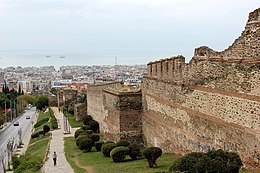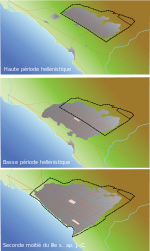Walls of Thessaloniki
| UNESCO World Heritage Site | |
|---|---|
 The eastern walls | |
| Location | Thessaloniki, Greece |
| Part of | Paleochristian and Byzantine Monuments of Thessaloniki |
| Criteria | Cultural: i, ii, iv |
| Reference | 456-002 |
| Inscription | 1988 (12th Session) |
| Coordinates | 40°38′00″N 22°57′10.5″E / 40.63333°N 22.952917°E |
 Location of Walls of Thessaloniki in Greece | |


The Walls of Thessaloniki (Greek: Τείχη της Θεσσαλονίκης, Teíchi tis Thessaloníkis) are the city walls surrounding the city of Thessaloniki during the Middle Ages and until the late 19th century, when large parts of the walls, including the entire seaward section, were demolished as part of the Ottoman authorities' restructuring of Thessaloniki's urban fabric. The city was fortified from its establishment in the late 4th century BC, but the present walls date from the early Byzantine period, ca. 390, and incorporate parts of an earlier, late 3rd-century wall. The walls consist of the typical late Roman mixed construction of ashlar masonry alternating with bands of brick. The northern part of the walls adjoins the acropolis of the city, which formed a separate fortified enceinte, and within it lies another citadel, the Heptapyrgion (Seven Towers), popularly known by the Ottoman translation of the name, Yedi Kule.
Gallery[]

The walls c.1919

Part of the walls with one of the surviving gates on the background

Part of the walls

Gate of Anna Palaiologina

Part of the walls beside the street

Walls in Ano Poli

"Portara" Gate

Trigonio tower (“Triangle Tower”)

View from the Triangle tower

Another view
Sources[]
- Kourkoutidou-Nikolaidou, E.; Tourta, A. (1997), Wandering in Byzantine Thessaloniki, Kapon Editions, pp. 15–26, ISBN 960-7254-47-3
External links[]
 Media related to Walls of Thessaloniki at Wikimedia Commons
Media related to Walls of Thessaloniki at Wikimedia Commons
- World Heritage Sites in Greece
- Buildings and structures completed in the 4th century
- Byzantine fortifications in Greece
- Byzantine architecture in Thessaloniki
- City walls in Greece
- History of Thessaloniki
- Tourist attractions in Thessaloniki
- Roman fortifications in Greece
- Byzantine Empire stubs
- Fortification stubs













